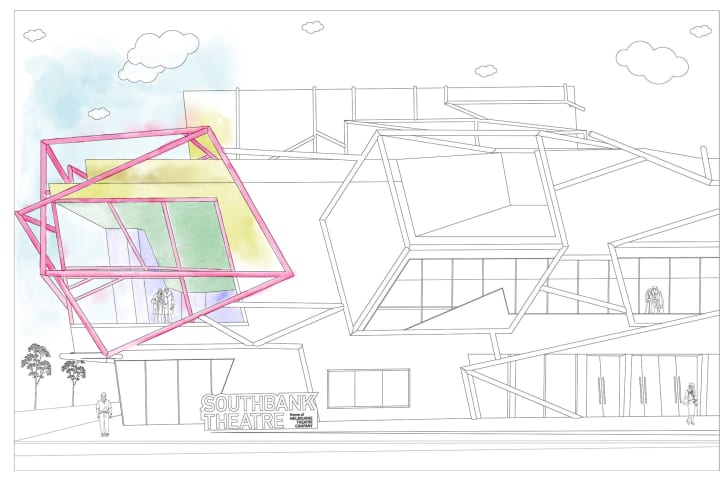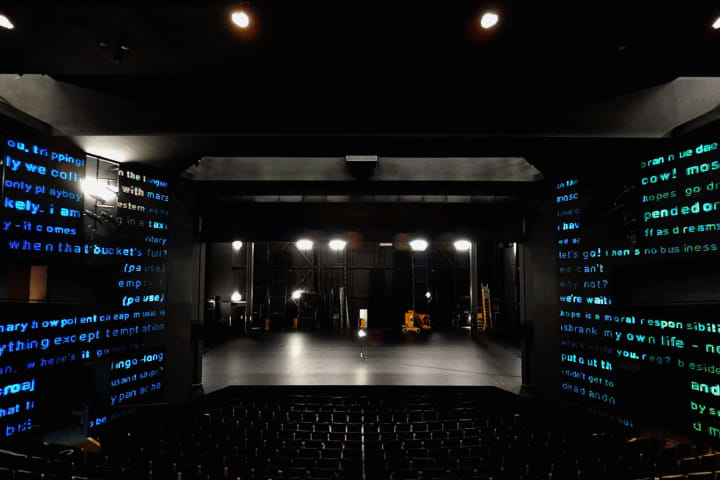The Southbank Theatre’s green room is green, in both name and colour. Located upstairs from the Sumner and Lawler stages, it’s a communal space open to performers and backstage crew, where they can go when they want to socialise between shows. Says former MTC Artistic Director Simon Phillips, who helped design the theatre, ‘I was also determined that the green room should have a balcony to the outside, so smokers could perch out there without missing my interminable note sessions, but that’s a different, less politically correct story.’
Actor Jing-Xuan Chan recalls that during Season 2019’s Golden Shield, fellow cast member Fiona Choi was gifted a puzzle – of a golden shield, naturally! – that she set up in the green room on opening night, for anyone to join in on over the show’s run. ‘It was fun to do with the team between a matinee and evening show,’ she says, ‘or even on my own if I got in to the theatre early.’
This social aspect is what differentiates the green room from the dressing rooms, but they were likely one and the same in the early days of theatre, as we discover below. Today, however, the concept of a separate, communal, waiting area known as a green room is so ubiquitous that it extends beyond the realm of the performing arts. In fact, the very first mention of a green room – in a 1666 entry in the diary of English naval administrator and future MP Samuel Pepys – referred to a room at King Charles II’s palace.
Where the green room of the theatre originated is a bit murkier, as is the reason behind the name. Some theories centre on the architectural history of performance spaces, others on literary references, and others still on what the rooms are used for.
Historical green rooms
In medieval theatres in the round, the performance area was often grass-covered, as is highlighted in A Midsummer Night’s Dream (Act 3, Scene 1), when Shakespeare has Peter Quince say ‘this green plot shall be our stage’. Actors took to referring to the stage as ‘the green’, a term still used by some today, and this has given rise to the theory of the green room as a waiting space on the way to ‘the green’.
Going back even further to Ancient Greece, plays were performed in open-air theatrons comprising the orchestra, or stage area; the skene, a tent or stone building behind the orchestra where players could change their costumes, and which often became part of the set; and the audience, or tiered seating built into the natural slope of the hill.
The green room could have evolved as a corruption of the skene, which is also where the words scene and scenic come from. In later years, the scene room was a place that doubled as a scenery storage vault and an actors’ waiting room. (Rhyming has also been put forward as an origin in the form of the Cockney slang word greengage – a type of plum – used to mean the stage, although rhyming slang didn’t exist until the 19th century.
Another historical theory is that there was an original green-coloured rest room, at either the 16th century Blackfriars Theatre or the 17th century Theatre Royal on Drury Lane, from which all others subsequently took their name, whether coloured green or not. But the reality may not have had anything to do with the colour of a real room at all, and instead be literary.

Frank Woodley in the green room during Twelfth Night. Photo: Sarah Corridon
Literary green rooms
The Oxford Companion to the Theatre lists the first reference to ‘Green Room’ as occurring in Thomas Shadwell’s 1678 play A True Widow, in a scene in which the gentleman Stanmore tells the Lady Busy about his earlier conversation with a foppish dandy named Selfish: ‘No madam; Selfish, this Evening, in a green Room, behind the Scenes, was before-hand with me.’
The term popped up again a couple of decades later, in the anonymously written 1697 play The Female Wits, when the character of Praiseall promises to ‘treat’ several actresses ‘in the Green Room, with Chocolate’. It appears yet again in actor Colley Cibber’s 1701 work, Love Makes Man: ‘I do know London pretty well, and the Side-box, Sir, and behind the Scenes; ay, and the Green-Room, and all the Girls and Women Actresses there.’
Green ‘green rooms’
Historical or literary, there’s little consensus about why, exactly, the colour green. As seen above, the early literary green rooms seemed to be spaces for women, but green isn’t traditionally a gendered colour. One common theory is that because the rooms are designed to be relaxation spaces they may originally have been painted a colour widely thought to be soothing, restful and restorative: green. Others have postulated that these rooms were once the domain of understudies awaiting their chance to make it onto the stage, and the green refers to their supposed youth or inexperience. There are even suggestions that equate the green room with stage fright – feeling ill, or green – or the nausea potentially felt by those getting ready to perform!
A less fanciful theory holds that this backstage room was once commonly covered in a green-dyed woollen cloth known as baize, either to provide soundproofing for actors rehearsing lines, or to protect the performers’ costumes (a 1662 document records an order of ‘one hundred and ten yards of green baize’ for London’s Cockpit-in-Court Theatre ‘for the upper tiring room, the walls being unfit for the rich clothes’). Why green baize? Perhaps it was simply on hand, as this was the cloth commonly used for the stage curtains, giving rise to the term ‘behind the green’, meaning backstage.
Or perhaps the colour relates to stage make-up. In the early days of theatre, make-up took a while to cure, or set, after application. While actors waited for this to happen, the make-up was apparently said to be ‘green’ or uncured, and it often cracked. This theory holds that the green room was where actors sat in still repose as they waited for their ‘green’ make-up to cure.
Whatever the reality is lost to time. But the green room is here to stay.
Published on 10 June 2020





